|
< Earlier Kibitzing · PAGE 2 OF 3 ·
Later Kibitzing> |
Mar-07-17
 | | tamar: <keypusher> All I have to say is... "It is amazing that players of Botvinnik, Keres, and Euwe's strength could analyze the resulting position so inaccurately":) Maybe it is very difficult. I agree that Keres note sounds offended that 17...Bxe5 should even be considered, and that could contribute to thinking there could be no resource. |
|
| Mar-08-17 | | zanzibar: Thanks everybody for all the fascinating additional input. (And a ha! right back at you <tamar>, indeed.) Personally, I think annotating a game can be, or should I say, really is, much more difficult than playing it otb. You're really supposed to "see" everything - and all that hard work doesn't even put you in contention for the prize money. OK, maybe correspondence is at the same level.
All the same, some annotators are noticeably much better, and more accurate, than others. And it is interesting to compare when two (or more) do the same game. Personal biases often show up, etc. There's also a little bit of competitive edge that I've noticed, e.g. sometimes Botvinnik goes into much more detail than normal when he gets to commenting on Keres comments about his game. * * * * *
Here is the Source tag for my version of the game: <Source "Botvinnik - Best Games (1947-1970) - G3 p14 / BCC v2 G375 p222"> The BBG book is an abbreviated translation of the 3-volume BCC book (BCC = Botvinnik's Creative Chess), translated by B. Chafferty (Chess Player pub.(?)), and published by Batsford in 1972. If you can read Russian, somewhere in here is the citation for v2 of BCC: <Батуринский Виктор Давыдович, составитель
«Шахматное творчество Ботвинника». Том 2Издательство: Москва. «Москва. «Физкультура и спорт», 1966 г., 704 стр.> http://webchess.ru/ebook/20/
Looks like this first came out in 1966, although I'm fairly sure Botvinnik keep notes as he played his career, and likely published the games in one or another of the Soviet chess magazines of the time (like Euwe likely did as well). BTW- does anybody know where I can find an online, safe, version of v3 to download? |
|
| Mar-08-17 | | zanzibar: keep = kept |
|
Mar-10-17
 | | Chessical: In the "The Hague-Moscow 1948: Match/Tournament for the World Chess Championship" by Max Euwe, he states: "The beautiful point. Now 20... e × f3 runs into 21. Bb1! h6 (the threat was B × h7 +) 22. R × f3 Nd5 23. Rg3!!, and Black will not be able to capture on h4 in view of mate in three." P.87. |
|
| Mar-10-17 | | Paarhufer: <Chessical> Is this the complete comment of 20.f3 in the English edition? The Dutch edition, which I consider to the original one, has an additional and longer paragraph (whose content I sketched already). -- BTW, Euwe had no less than four collaborators for this book: Eggink, Hannak, Slavekoorde and Zittersteyn. And Euwe often gave only his name for a publication, and sometimes any authors or co-authers were kept back. |
|
Mar-11-17
 | | Chessical: <Paarhufer> The note does have a second paragraph: "Also, 20. .. Be6 is suspect in view of 21. f × e4! B × a2 22. R × f6!, after which 22... g × f6 23. B × f6 immediately leads to mate. This means that Black will have to find a different continuation; but because of the tremendous power of bishop on c3, he remains in trouble." |
|
Mar-13-17
 | | keypusher: <chessical> Thank you -- what did Euwe have to say about his decision to accept the pawn sacrifice at move 17? |
|
Mar-13-17
 | | perfidious: <keypusher....I've only looked at a few games in the book, but I've found lots of mistakes. Yet Keres and Botvinnik were conscientious and well-regarded annotators. Annotating chess games is really hard! About as hard as playing them....> I'll sign that--in the late 1980s, I was games editor of <Chess Horizons> for a time, and it was not at all easy, not being one-tenth the player either Keres or Botvinnik was. |
|
Mar-14-17
 | | Chessical: <Keypusher> Euwe wrote: <17. Ne5! B×e5?> "Black retains good chances of equalizing after 17... Be6 18. Bb1 Bd5!, for example 19. f3 B×e5 20. d×e5 Q×e5 21. Bc3 Qe6! 22. B×f6 Q×f6 23. Q×f6 g×f6 24. f×e4 Be6, and Black’s position is not inferior." |
|
| Apr-02-17 | | storminnorman2010: Poor Euwe! This tournament, along with the Zurich tournament in 1953, was his swan song in trying to reclaim the world chess championship. |
|
| Dec-19-19 | | Inocencio: Pin is mightier than a sword. The exploitation of weak F7 square is the winning key of this game. |
|
Jan-19-20
 | | KEG: Much ink has been spilled in analyzing this interesting and important game. As Kasparov and several of the fine contributors on this site have noted, Euwe's 20th move was a mistake and much of the earlier writings about the merits of alternatives were flawed. Without in any way intending to diminish the excellent discussions about move 20 and its aftermath, the earlier portions of the game were also noteworthy. This game was played in the 2nd round. It was Botvinnik's first game in this tournament because he had a 1st-round bye. At the time the game was played, Keres had shot into the lead, defeating Euwe in their opening game. As we now know, Botvinnik won this tournament by an overwhelming margin, and Euwe finished dead last with an awful score of 4-16. But the players of course had no inkling of what lay ahead (except that Botvinnik was the pre-tournament favorite. He had winning records against the other three competitors. But he had lost twice to Euwe and their other games were all drawn. Having taken Botvinnik's measure in two earlier contests, Euwe came armed for this encounter, and had some surprises in the opening. In fact, both players handles the first part of the game well, and prior to Euwe's poor 20th move and his shell-shocked play in the moves after that, he had achieved an approximately even game. The older commentators, perhaps feeling a need to explain Euwe's defeat, faulted much of his early play. Most of this criticism, as I will try to show, was faulty. The drama must have been intense as this game began. It reviewing this game, I have tried to keep in mind that it was played in real time without the benefit of opening theory developed over the course of the last 70 years and--of course--without the benefit of computers. 1. d4 d5
2. c4 e6

click for larger viewAs early as move 2, Euwe had a surprise for Botvinnik: "In their previous meeting at Groningen 1946, Dr. Euwe accepted the Queen's Gambit, and the game ended in a draw." (Golombek) "Previously Euwe mainly utilized the Slav Defense by 2...c6, or chose to play 1...f6...and continued with either the Nimzo-Indian or Grunfeld Defences. But in this tournament the ex-World Champion gave up his previous repertoire in favor of different, more experimentl, opening systems..." (Keres) 3. Nf3 Nf6
4. Nc3
"Showing a readiness to enter into the variation 4...c5 5. cxd5 Nxd5 [5...cxd4 and 5...exd5 are probably better--KEG] 6. e3 [6. e4 seems better--KEG] which he has played so often before..." (Golombek). 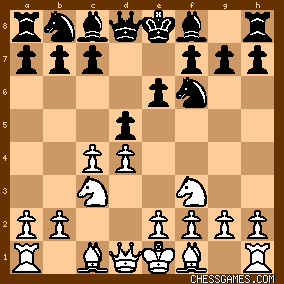
click for larger view4... c6
One might have expected 4...c5 or maybe 4...dxc4. But, as will be seen, Euwe had a different plan in mind. Under the circumstances of this game, the text was definitely a reasonable choice: "The continuation considered theoretically strongest is 4...c5 5. cxd5 Nxd5 and after 6. e3 it leads to a position that Botvinnik very much enjoys playing, and it has brought him excellent results. Hence Euwe's desire to avoid these lines here is fully understandable and, in my opinion, also correct. Moreover, it was unlikely that Botvinnik would use the system 5. Bg5 dxc4 6. e4 b5 7. e5 h6, where theory, it's true, has not reached a final consensus, but which he likes to play with Black." (Keres) 5. e3
"He avoids the dangerous but attractive Anti-Meran Gambit...as he is certain Dr. Euwe must have thoroughly analyzed it beforehand. As Black, Botvinnnik himself beat Denker in this line in the U.S.S.R.--U.S.A. radio match..." (Golombek). 5... Nbd7
"As though about to play the Meran Defense." (Golombek). "Here 5...a6 6. c5 ["strong"--Golombek] Nbd7 7. b4 a5 [7...b6 seems better--KEG] 8. b5 e5 leads to very sharp play, as in the game Reshevsky-Keres from the third cycle. In addition, a transition into the Stonewall Defence by 5...Ne4 6. Bd3 f5 is possible and is a quite satisfactory continuation for Black after the closing in of White's c1-bishop by the move e3." (Keres) As will be seen, Euwe had a very different plan in mind. 6. Bd3
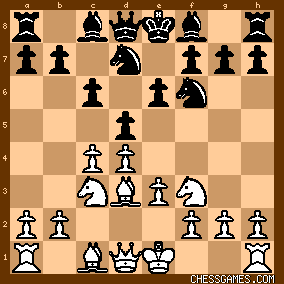
click for larger viewEuwe here was at the cross-roads: should he go in for a Meran variation or try something else? |
|
Jan-19-20
 | | perfidious: <KEG....But (Botvinnik) had lost twice to Euwe and their other games had all been drawn....> In the 1970s, Botvinnik admitted that Euwe's penchant for what he termed 'long moves' caused him some trouble in their early encounters. |
|
Jan-19-20
 | | KEG: Post II
6... Bb4
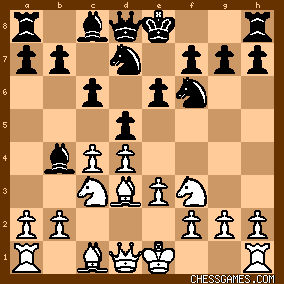
click for larger view"One of the ways to sidestep the Meran. Van Scheltinga has often played this type of Half-Meran of late." (Euwe) "...he branches off from the Meran to a line reintroduced by Romih at San Remo 1930...The idea (originally Tchigorin's) is to force an early e5 by Qe7 and an eventual retreat of the Bishop either to d6 or c7. This plan, if successfully carried out, would give Black excellent attacking chances on the King side, but its fundamental unsoundness lies in the fact that it prematurely and violently opens up the center..." (Golombek). 6...dxc4 does seen sounded and arguably better, but the text may have had some surprise value, is certainly playable, and Euwe perhaps was well armed for this variation. Most of the contemporary commentators shared Golombek's distaste for the text: "A strange move that has been played regularly by only two men: the Italian Romi about twenty years ago and the Dutchman van Scheltinga...it was once tried by Tchigorin and once by Alekhine (against Euwe, 1937 match, 3rd game). Recently Keres adopted the move unsuccessfully against Novotelnov in the Tchigorin Tournament at Moscow. It is one of three Semi-Meran variation Black has at his disposal if he wants to avoid the Meran...It looks inferior, but most of the examples available show Black coming out well." (Kmoch) "This defense, which attracted broader attention after the Euwe-Alekhine match in 1937, is fully playable for Black, although not without certain risks. In my opinion, Euwe made the wrong decision here...Because more open and positionally clear positions suit his playing style better...I believe the most suitable continuation for Euwe's playing style was a transiation to the Meran Defense by 6...dxc4 7. Bxc4 b5 8. Bd3 a6..." (Keres) 7. a3
"Botvinnik's own move, and one that is as strong as it is simple..." (Golombek) "7. 0-0 0-0 8. Ne5 [8...Qc2 or 8. Bd2 are better--KEG] has been much analyzed and repeatedly played in Holland..." (Kmoch). "White has to make this move at once, since for example after 7.0-0 0-0 8. a3 Black could favorably transpose to the Tchigorin Defence with 8...Bd6 9. e4 dxc4 10. Bxc4 e5." (Keres) In fact, the text and 8. 0-0 both have their points. The text goes back to Pillsbury-Albin 1894 and Vidmar--Marshall Karlsbad 1911 both games were won by White). Euwe himself had played the move. 7... Ba5
7...BxN+ and 7...Be7 look better. But commentators c. 1948 disagreed: "It is clear that 7...BxN+ merely strengthens White's center, and gives him the advantage of two Bishops. This was demonstrated in the third match game between Dr, Euwe and Alekhine [which was drawn--KEG but in which, in Golombek's opinion, White obtained much the better position from the opening." (Golombek) "7...BxN+ 8. bxB 0-0 9. 0-0 Qc7...is slightly but definitely better for White..." (Kmoch). The position after 7...Ba5 was:
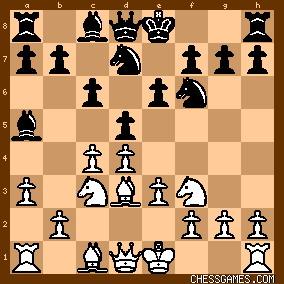
click for larger view8. Qc2
"The obvious 8. b4 is incorrect as it merely forces the Bishop to a better position..." (Golombek) "It is important to realize that 8. b4 Bc7 9. e4 does not have the same effect as in the analogous continuation of Tchigorin's Semi-Meran." (Kmoch). I agree that 8. Qc2 is probably better than 8. b4, but that move is also OK since after 8...Bc7 White need not play e4 but can get the better game with 9. 0-0 or 9. Bb2. But not everyone loved 8. Qc2:
"It is difficult to justify this move, since White is not doing anything to prevent Black's strategical plan of dxc4 followed by e5. It was better to...play 8. 0-0..." Like it or not, the position after 8. Qc2 was:
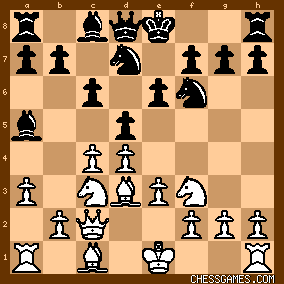
click for larger viewWhite is definitely better here, but the position is double-edged and I would have been on the edge of my seat had I been among the privileged spectators back in 1948. |
|
Jan-19-20
 | | KEG: <perfidious> <In the 1970s, Botvinnik admitted that Euwe's penchant for what he termed 'long moves' caused him some trouble in their early encounters>. And, as I will try to show in my commentary, Euwe's long-range strategical ideas in this game gave Botvinnik problems until Euwe lost his way beginning on move 20. |
|
Jan-19-20
 | | KEG: Post III
8... Qe7.
8...0-0 (or maybe 8...Qc7) was better. Botvinnik thought 8...Qe7 was a mistake: "A poor move. 8...0-0 as Taimanov played against me in the U.S.S.R. Championship playoff (1953) is better." Golombek agreed:
"This move is a professed part of Black's system, but it would be better to abandon it and play instead 8...0-0 9. 0-0 Bc7 10. e4 dxc4 11. Bxc4 e5." Keres, however, disagreed and thought that 8...Qe7 was part of Black's planned development: "Now nothing can be done to stop the e5 advance..." 9. Bd2
"This seems to be stronger than the fianchetto which is usually played in this position (O'Kelly v. Scheltinga, Beverwijk 1946)." (Kmoch) Botvinnik could also have played 9. 0-0 first, with Bd2 to follow. The position was now:

click for larger view9... dxc4
"?"--(Kmoch)
"Black plans to free his Queen Bishop, but this is premature and should cause great difficulties. 9...Bc7 is better, notwithstanding that White that White can exchange that Bishop for a Knight: 9...Bc7 10. cxd5 exd5 11. Nb5 Qd8 (forced) [Not really--Black could also play 11...Bb8--KEG] 12. NxB QxN. Although certainly favorable for White (13. b4!) this variation offers Black better fighting chances than the move played." (Kmoch). A comparison of Kmoch's final position with what occurs in the game suggests that 9...Bc7 would not have been any improvement over the text, which allows Black to retain his dark-square Bishop without burying it on b8. Botvinnik agreed that 9...Bc7 was best, but gave no variations to support his claim. Golombek had a different notion, but his analysis was flawed: "Once again Black errs through too close an adherence to his original plan. He should play 9...0-0 10. 0-0 Bc7 (not 10...Re8 11. Nxd5 exN 12. BxB) 11. e4 [11. cxd5 is much better and gives White much the better game after 11...exd5 12. Nb5! Qd8 13. NxB+ QxN 14. b4--Keres] dxc4 12. Bxc4 e5." But Golombek's reasoning is based on the poor 11. e4 rather than 11. cxd5. The best analysis of this move was by Keres, who recognized that the text is necessary before White can play e4, and--as noted above--identified the error in the analysis supposedly supporting 9...0-0. 10. Bxc4 e5
11. 0-0 0-0
11...e4 was impossible because of 12. Nxe4." (Euwe)(and Golombek similarly). After 11...0-0 the position was:
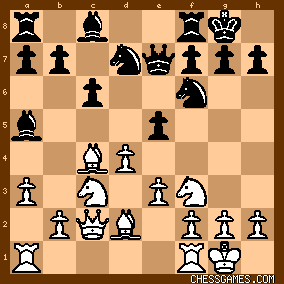
click for larger view"Black has been able to carry out his opening idea, but despite this, he has not been completely freed from the difficulties related to developing the bishop from c8. Thanks to the fact that his pawn still stands on e3, White can maintain the tension in the centre, and strengthen his position further. Black, on the other hand, is forced to be the one who releases the tension in the centre if he wants to develop his bishop from c8." (Keres) White is indeed better here. But Euwe was not concerned. We know this because he repeated this variation three rounds later against Reshevsky, who--as I will discuss in my next post--had a surprise prepared for Euwe. The question at hand is how White should try to capitalize on his undoubtedly superior position. Was Botvinnik's method best? Was Reshevsky's? Or was something else in order? |
|
Jan-19-20
 | | KEG: Post IV
12. Rae1
Botvinnik liked this move:
"A cunning move. Now Black finds it hard to find a satisfactory answer..." But everyone else disagreed. The majority opinion was echoed by Kmoch, who described 12. Rae1 as follows: "In order to start an attack by advancing the King Pawn and King Bishop Pawn at the right moment. This aggressive idea leads to nothing. The right line was shown in the 5th round by Reshevsky: 12. d5!" As the further course of the game showed, Kmoch's doubts about Botvinnik's 12. Rae1 were well founded. But what about Reshevsky's move (12. d5). It would leave the position as: 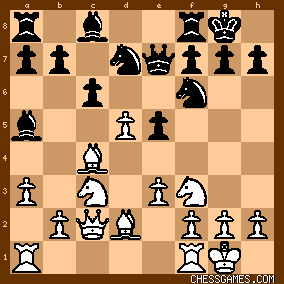
click for larger viewIn his 5th round game against Reshevsky, when confronted with this move, Euwe played 12...c5? and lost. Euwe aptly called 12...c5? "the worst possible move." Golombek, Keres, and Wade--Whiteley Keene all gave Euwe's move a "?" Keres was most emphatic and called it "a decisive mistake...really bad, since later White's strong d-pawn prevents Black developing his pieces." The merits of 12. d5 therefore cannot be judged by what happened after Euwe's 12...c5? against Reshevsky. Keres stated that after 12. d5 Black had "several continuations at his disposal that could have given him an approximately equal game..." He lists 12...BxN, 12...Nb6, and 12...Bc7 as among Black's best options. Wade-Whitely-Keene give the same three moves. Euwe adds a fourth (12...e4). Since this post deals with Botvinnik-Euwe and not Reshevsky -Euwe, I shall confined myself to considering 12...BxN (which is what Fritz gave me when I fed this position to the beast). 12...BxN 13. BxB cxd5 14. Bb4 is where all of the analysis begins. Golombek and Keres then only consider 14...Nc5, after which White gets the better game with 15. Bxd5 NxB 16. BxN Qc7. Keres claims that "Black has nothing special to fear, even though White's position is somewhat freer." But after 17. Rfc1 White is clearly on top. Euwe is also correct that White would be better after 17. Rac1, but he (and Golombek in his commentary) only considers 17...Re8, while 17...Rd8 leaves Black in reasonable shape. In any case, in the above line, with best play White is plainly better after 14...Nc5. But Keres and Golombek overlooked what Euwe found: the pretty exchange sacrifice via 14...Qe6! Then, Black winds up just fine after 15. BxR dxB 16. Bb4 a5 17. Bc3 b5 after which Euwe (correctly in my view) concludes that "Black has reasonable compensation for the exchange." If Euwe's analysis is correct, it seems to follow that Reshevsky's 12. d5 is, to quite Keres: "...hardly sufficient to assure White of an edge. So what should White play after 11...0-0?
Only Keres found the answer (and the move selected by Fritz and Stockfish): 12. Ba2! To quote Keres further: "Now [after 12. Ba2] 12...Bc7 is no longer possible due to the reply 13. Nb5, and secondly Black has to consider the threat of 13. Nd5. If, for example, 12...Bb6 [best--KEG] then 13. Rae1 (or even better 13. Rfe1 or 13. Na3) and Black has run out of reasonable moves." While. contra Keres, I do not think White has a won game after 13. Ba2!, there is no doubt that White is much better and that 13. Ba2 is the best choice for White. Keres aptly summed up the situation:
"It seems that White could have maintained an opening advantage with 12. Ba2!, but the edge gradually vanishes after the hasty text move. To return to the game, the position after Botvinnik's 12. Rae1 was: 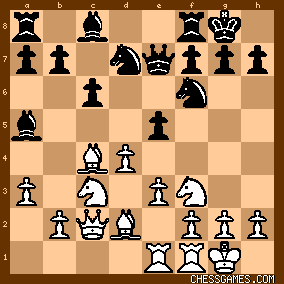
click for larger view12... Bc7
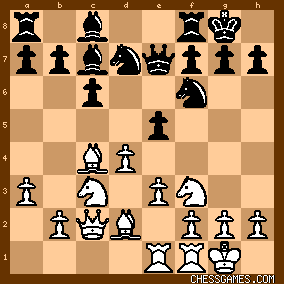
click for larger view"Now Black is ready for e4." (Euwe)
"Now Black already threatens e4, which White has to prevent." (Keres) "Black completes the first part of his mobilization. The two tempi he has lost with his Ling have no major importance." (Kmoch) In sum, Euwe had nearly equalized. The battle loomed ahead. |
|
Jan-20-20
 | | KEG: Post V
13. Ne4
"!"--(Botvinnik)
"This prevents the threatened 13...e5 (14. Ng5 Bxh2+ 15. KxB Ng4+ and 16...QxN) and simultaneously threatens 14. Bb4." (Botvinnik). Botvinnik's praise of this move is a bit too much. It basically leads to equalizing exchanges. "Instead of this exchange, which eases Black's position, 13. Bd3 came into consideration." (Keres) 13. Bd3 does indeed look like a better try, but Keres' analysis of this alternative was flawed: "13...Re8 (13...a5 to keep an eye on b4 was better) 14. dxe5 (14. Ng5 and---since Black hasn't played a5--14. Ne4 were somewhat better) Nxe5 15. NxN QxN (better than Golombek's 15...BxN 16. f4 Bc7 17. e4 Ng4)." But Keres acknowledges that gets a "tenable position" in his line after 16. f4 Qh5 ((16...Qc5 looks even better and seems to equalize). So if neither Botvinnik's move nor that of Keres gives White anything, is there anything better? 13. e4?!, a move considered but rightly rejected by Golombek, gets White nowhere after 13...exd4 14. Ne2 Qxe4 15. Bd3 Qd5 16. Nexd4 Nc5. Even worse, and maybe even losing for White is Golombek's 14. Nxd4? Qd6 (much better than Golombek's 14...Bxh2+ 15. KxB Qe5+ [15...Qd6+ is better]16. Kg1 QxN 17. Be2]). Golombek and Kmoch also considered and correctly rejected as of "doubtful value" trading via 13. dxe5 [or beginning with 13. Nxe5] Nxe5 14. NxN QxN in light of 15. f4 Qh5 [or perhaps 15...Qd6 or 16...Qe7--KEG] After which White gets into trouble after Golombek's 16. h3 Bf5 or Kmoch's 16. Ba2 Bf5 (he considers only 16...Re8) and can only equalize with the better 16. Ne4 or 16. Bd3. If White wants to play for any semblance of an advantage, the best chance may be to make room for his Knight to retreat by playing the awkward 13. Bc1 or maybe even 13. Kh1. Stockfish favors 13. Bd3, but as discussed above, this also fails to get Black any real edge. So let's return to Botvinnik's 13. Ne4, the position now being: 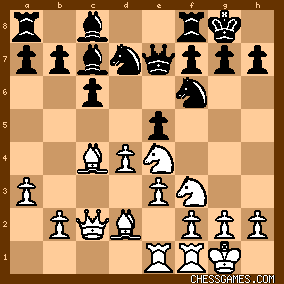
click for larger view13... NxN
14. QxN

click for larger view14... a5
"?"--(Golombek)
Like Rodney Dangerfield, this perfectly logical move (and probably Black's easiest way to equalize) gets no respect from the commentators: "Weakening his Q-side and losing valuable time." (Botvinnik). "A weak move at a critical point." (Golombek)
"An unnecessary loss of time..." (Keres)
The alternatives these critics mention, with one possible exception, are all . A) Golombek's 14...Nf6 gives White a small edge after 15. Qh4 e4 16. Bb4 [Keres' 16. Ne5 would lose this edge after 16...a5 instead of his proposed 16...Be6)] Bd6 17. BxB QxB 18. Ng5 Bf5 [perhaps better is 18...b5] 19. f3. B) Golombek's alternative of 14...Re8 is no better and again yields a small advantage to White after 15. Bb4 [all the alternatives to Euwe's move leave this available] Qd8 (better than Golombel's 15...Qf6 16. Rd1). C) Keres' 14...Kh8 is quite bad for Black after 15. Bb4 c5 [Not 15...Bd6? 16. Ng5--KEG] 16. Bxc5 [better than Keres' 16. dxc5 a5) NxB 17. dxN. The only true alternative to Euwe's 14...a5 is 14...Bd6 as suggested by Euwe, Botvinnik, and (according to Keres) Makogonov. This also seems to yield approximate equality after 15. Bb4 BxB 16. axB Nf6 17. Qxe5 Qxb4. In sum, Euwe's 14...a5, far from being an error or blunder, was as good as anything, and left the position as follows: 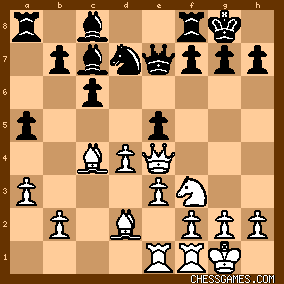
click for larger view |
|
Jan-20-20
 | | KEG: Post VI
15. Ba2
"!"--(Euwe)
"A subtle move to prepare 16. Bc3." (Euwe)
"A necessary precaution." (Golombek)
If 15. Bc3 immediately, then--as discussed by Golombek, Euwe, and Keres-- 15...Nf6 16. Qh4 e4 17. Ne5 (Not 17. Nd2?? b5 which loses a piece--Golombek) Be6 and Black, if anyone, is better. White also gets nowhere, as Kmoch showed, with 15. Nxe5 NxN 16. dxN (not 16. f4? Bf5--Kmoch) Qxe5 17. QxQ BxQ "...as he must lose a tempo to save his Queen Knight Pawn" (18. Bc3 BxB 19. bxB leads to a drawn ending at best for White). Probably the best choice for White here was not discussed by any of the commentators: 15. b4. But this is also no great shakes, since Black is fine after 15...Nf6 16. Qc2 e4 17. Ne5 a4. After 15. Ba2 the position was:
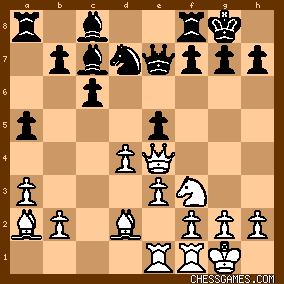
click for larger view15... Nf6
This fairly obvious move was criticized--unfairly--by Golombek and Euwe, who claimed that 15...Kh8 was better. "Black does not foresee White's possibilities of attack by a Pawn sacrifice, otherwise he would play 15...Kh8 (threatening f5) 16. dxe5 Nxe5 and though White preserves his initiative by 17. Nd4 [17. NxN is just as good--KEG] Black's game is quite tenable." (Golombek). "With 15...Kh8! Black retains reasonable play, since he then threatens 16...f5..." (Euwe). Keres disagreed and argued that White is better in Golombek's line than in the game. In fact, both moves seem OK for Black. The rush to condemn 15...Nf6 seems to stem from a mistaken belief that Botvinnik's coming 17th move pawn sac gave White a major if not winning advantage. As will be seen, this analysis was wrong. 16. Qh4

click for larger view16... e4
"He decides to win the pawn rather than submit to 16...exd4 17. dxe4 or 16...Be6 17. Bb1 when White threatens both Bxh7+ and dxe5." (Golombek). White does indeed emerge with far the better game and excellent winning chances on either of Golombek's alternative moves. By any reckoning, the text was best. It left the position as follows: 
click for larger view"With the Queen Bishop ready to go into action and White's plan of advancing his Pawns frustrated, Black has a fully satisfactory game. It even looks as if he had the advantage since the attacked Knight seems to lack a good flight square." (Kmoch) The climax of the game had arrived, and Botvinnik's brilliant idea was about to be unveiled. As will be seen, however, Euwe would have been fine with best play. Over the board, however, handling Botvinnik's upcoming assault was by no means a simple task. |
|
| Jan-20-20 | | Cibator: Golombek annotated this game a second time a few years later in his well-regarded (in its day) “The Game Of Chess”. It was of course in far less depth, but even so some of the differences from his earlier effort make interesting reading (for a start, the name of the opening variation, which he renders as the “Half Slav Defence”). References below, except where stated otherwise, are to TGOC, 1961 Penguin reprint. I’ve algebraicised the notation, which was originally in Descriptive. At Black’s sixth move: “This pin does not achieve much; better is 6. … Bd6”. No mention of that …. dxc4 alternative, nor any explanation of why his suggested move is better. At Black’s ninth: “Castles was still to be preferred.” And that’s it. On White’s twelfth, he has this to say: “A far-sighted move. Botvinnik sees that Black will eventually play … e4, and therefore prepares to support the KP so as to be able to reply with f3. The KR is wanted on f1 where it can profit from the opening of that file.” At Black’s fourteenth: we’re given the 14. … Nf6 line already cited by KEG, but after 19.f3 HG adds … Rae8 with the comment “ … and Black has good chances of holding the game”. HG then rather inexplicably slides over the next few moves, giving no comment at all until White’s nineteenth. So I’ll stop there for now, and wait for KEG to carry the story forward again. |
|
Jan-20-20
 | | KEG: <Cibator>Thank you for this important addition. I was unaware of this second Golombek publication on the 1948 World Chess Championship, but I will try to hunt it down before I get to work on any other games from this tournament. |
|
| Jan-21-20 | | Cibator: <KEG>: "The Game Of Chess" wasn't about the 1948 World Championship event; it was a general textbook for intermediate-strength players. (Although there were a few introductory chapters as well, explaining the rules and other elementary matters, these were too rushed to be much use to complete beginners). One of the later chapters was a survey of great players, with illustrative games by each. The Euwe game was the one chosen for Botvinnik. And as I've indicated, the annotations were pitched at a less sophisticated level of chess understanding, and were not of the same depth as in the 1948 book. |
|
Jan-21-20
 | | KEG: Post VII
Thus far, I have been citing older commentators and my own Beginning here, we also have the analysis of Garry Kasparov and some fine analysts on this site. 17. Ne5
"!"--(Kmoch)(Euwe)(Keres)(Botvinnik)(Kasparov)

click for larger view"The combination Botvinnik had in mind." (Kmoch) "A natural pawn sacrifice which Black should certainly not have accepted." (Botvinnik) "Takes advantage of Black's lack of development." (Knight13 on this site) "A nice sac of [a] Pawn for activation of [his] dark square Bishop." (Honza Cervenka on this site). "Forced because the alternative 17. Ng5 h6 18. Nh3 Qd6 19. Qg3 (or 19. Qf4--KEG) is weak." (babacova on this site). As babcova has pointed out, 17. Ng5 would be poor. Golombek made a similar point, but (in babacova's line) Golombek gave the inferior 18...Nd5 which allows White to equalize with 19. QxQ. babcova's move is far better and gives Black a clear edge. Keres found the same 18...Qd6 that babacova did. Perhaps even better would be 18...Be6. What seems clear beyond doubt is that 17. Ne5 was best. But how strong was it? As I will attempt to show, Black was fine after 17. Ne5. How should Black respond?
17... BxN
"?"--(Kmoch)(Euwe)(Keres)
"It is hard to understand why Euwe takes this great risk without (as the continuation shows) having a clear idea how to meet the consequences. 17...Be6 is evidently indicated and leads to quite a good game for Black." (Kmoch) "...Black should not have accepted [the] sacrifice." (Botvinnik) 'It is amazing that a player of Euwe's strength could asses the resulting position so inaccurately...Even if it would have been too brave to claim that Black's position is lost after accepting the sacrifice [and it is not--as Keres' own analysis eventually reflects--KEG] one can however certainly claim that from now until the end of the game he has to fight with difficulties and is unable to restore complete equality even with the best defense. Such a desperate attempt would have been justified only if Black lacked better defensive resources. But as a matter of fact, Black possessed A FULLY SATISFACTORY POSITION AND SIMPLY HAD TO COMPLETE THE DEVELOPMENT OF HIS QUEENSIDE WITH THE MOVES 17...Be6 18. Bb1 Bd5." (Keres) While there has been much criticism of Botvinnik and others for considering the game lost for Black after accepting the sacrifice with 17...BxN. But in fairness to Keres, Kmoch, Euwe, and Botvinnik, they spotted the best move here: 17...Be6. While, as will be seen, Black still had a tenable game after accepting the sacrifice, Keres and Botvinnik were correct that Black would have had a much easier time with 17...Be6. After 17...Be6, Black has at least equality. e.g., 18. Bb1 (best, Black is clearly better after 18. BxB QxB) Bd5. ("Many commentators consider this position as favorable for White, but it is difficult to prove this in any concrete way"--Keres). 18...Rfe8 was also fine for Black. After 18...Bd5 in the above line, the position would have been: 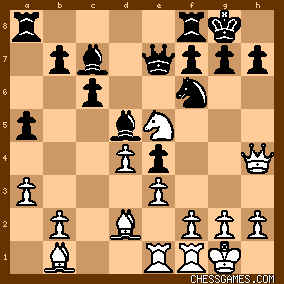
click for larger viewTwo main lines have been suggested by the commentators here for White, neither of which yield any edge for White: A) If 19. Bc3 Black has "adequate defensive resources." (Botvinnik. Kasparov says that Black "has a good position" here. Based on Kasparov's commentary, in an earlier commentary Botvinnik said that White "retained the advantage" here. In any case, there is no dispute that Black's position is tenable at least. But all this may be beside the point, since after 19. Bc3 Black is better after 19...b5. B) 19. f3 was considered by Golombek, Keres, and Euwe. It also gives White no advantage. As Keres stated, Black "can simply proceed with 19...Rfe8." Botvinnik similarly said that Black has "adequate defensive resources" with 19...Rfe8. 19...BxN (given as best by Euwe and Golombek) is not as good as 19...Rfe8, but, as Euwe has shown, Black is still OK. The conclusion seems inescapable that Black would have been fine had he declined the sacrifice with 17...Be6. But Euwe played 17...BxN. Play then continued:
18. dxB Qxe5
19. Bc3

click for larger viewIs there a win here for White? |
|
Jan-21-20
 | | KEG: <Cibator> <"The Game Of Chess" wasn't about the 1948 World Championship event; it was a general textbook for intermediate-strength players> Thank you for the clarification. |
|
Jan-21-20
 | | KEG: Post VIII
19... Qe7
Not 19...Qh5? 20.BxN (Golombek)(Kasparov)
20. f3
"!"--(Kasparov)(Euwe)
"The beautiful point." (Euwe)
"Of course not 20. BxN QxB 21. Qxe4 [This is awful. 21. QxQ gxQ 22. Rd1 or 22. f3 leaves White in decent shape--though not as good as what he got with 20. f3] Bf5 22. Qc4 b5 [a bad move from Golombek. The simple 22...Qxb2 leaves Black with a likely win Golombek seemed to think that the text wins the exchange for Black, but not after 23. Qe2 Rad8 24. e4! with approximate equality]. Whatever the flaws in some of Golombek's analysis,it is clear that 20. BxN is far inferior to 20. f3. The position after 20. f3 was:
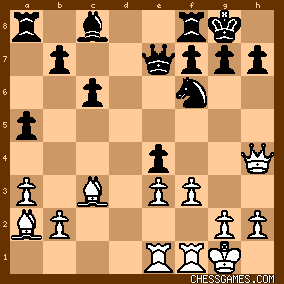
click for larger viewThis is the key position from which all of the arguments begin. 20... Nd5?
"?"--(Kasparov)
It is quite clear that Euwe was in deep trouble, if not outright lost, after this move. The question is whether Euwe could have achieved decent chances with 20...exf3 or 20...Be6. Until recently, most commentators believed that 20...exf3 led to a hopeless position for Black. That analysis has been--as I will show--refuted. Black can almost certainly survive with best play after 20...exf3. Much of the commentary on this site and elsewhere fault Keres, Botvinnik, and other for failing to see the superiority of 20...exf3 to Euwe's actual 20...Nd5? As I will attempt to show, while Keres and Botvinnik erred in their analysis of 20...exf3, they DID note what I think is Black's best move: 20...Be6, which also appears to save the day for Black. On this post, I will show that 20...exf3 was indeed playable. In my next post, I will discuss 20...Be6 and show that this alternate was also playable and probably best. So now as for 20...exf3. This would have left the position as follows: 
click for larger viewBest for White now is 21. Bb1 (21. Rxf3 leaves Black fine after 21...Nd5 22. QxQ NxQ). After 21. Bb1, the position would have been:

click for larger viewBotvinnik, Keres, and all of the earlier commentators here only considered the losing 21...h6? which gets crushed by 22. Rxf3 and now if 22...Nd5 (the heroic 22...Bf5 might hold on longer but is obviously no reason to play on) 22. Rg3!! (a gorgeous Queen sacrifice) QxQ (other moves avoid getting mated immediately but were obviously hopeless) 24. Rxg7+ Kh8 25. Rh7+ Kg8 26 Rh8 mate. But, as Kasparov and others on this site have pointed out, Black can avoid all of this with 21...Re8! Now Black is OK after 22. BxN (not 22. Rxf3 Ne4--Kasparov) QxB 23. Qxh7+ Kf8 [thanks to 21...Re8 Black can now escape as noted by zanzibar on this site] 24. Rxf3 Qh6 The above line would leave the position as:
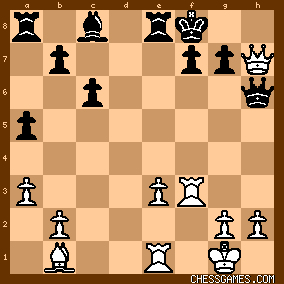
click for larger viewWhite is perhaps a bit better here, but Black should be able to hold. So how, asks tamar on this site, could Euwe, Keres, and Botvinnik all miss this? The answer, I think, lies in the fact that they: (i) recognized that 20...Nd5? was bad; and (ii) found what looks like a saving move in 20...Be6. For this reason, they did not look carefully at the merits of 20...exf3. In my next post on this game, I will consider 20...Be6. |
|
 |
 |
|
< Earlier Kibitzing · PAGE 2 OF 3 ·
Later Kibitzing> |
|
|
|





